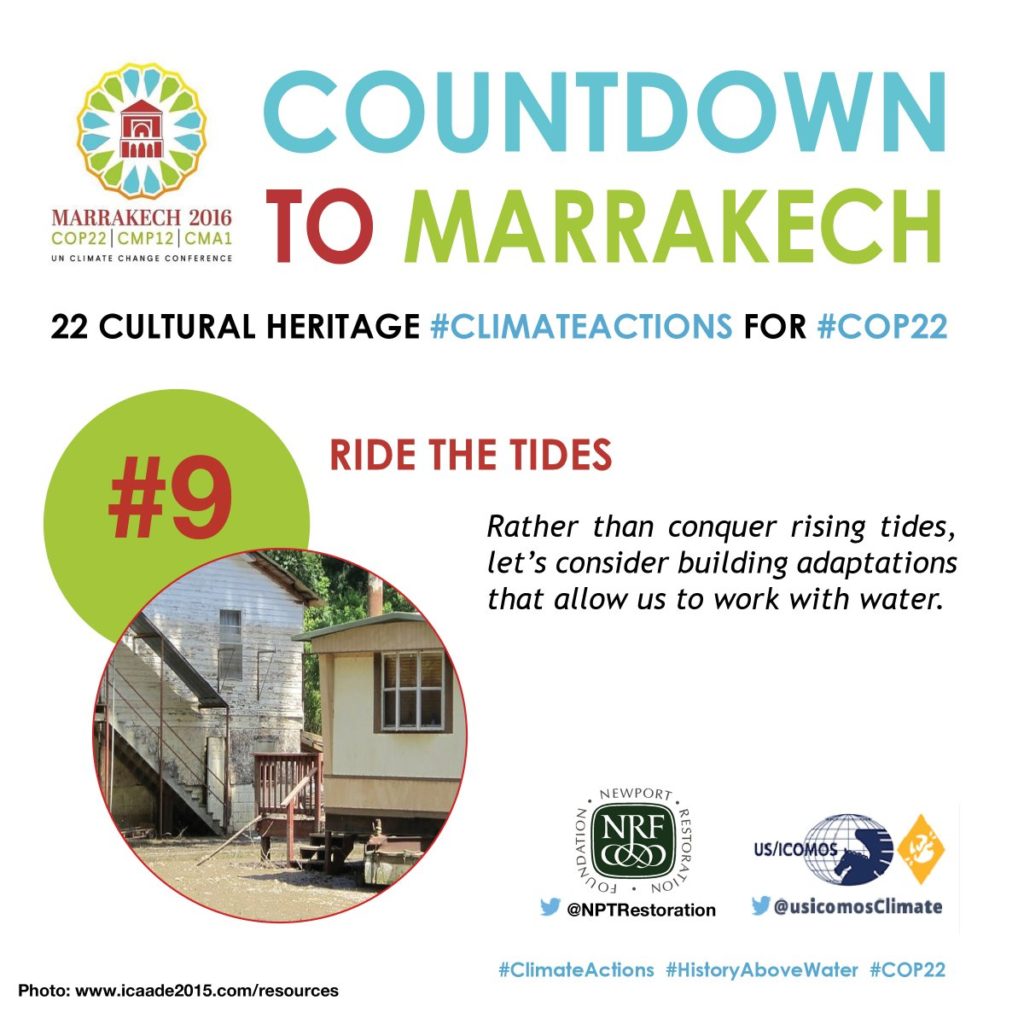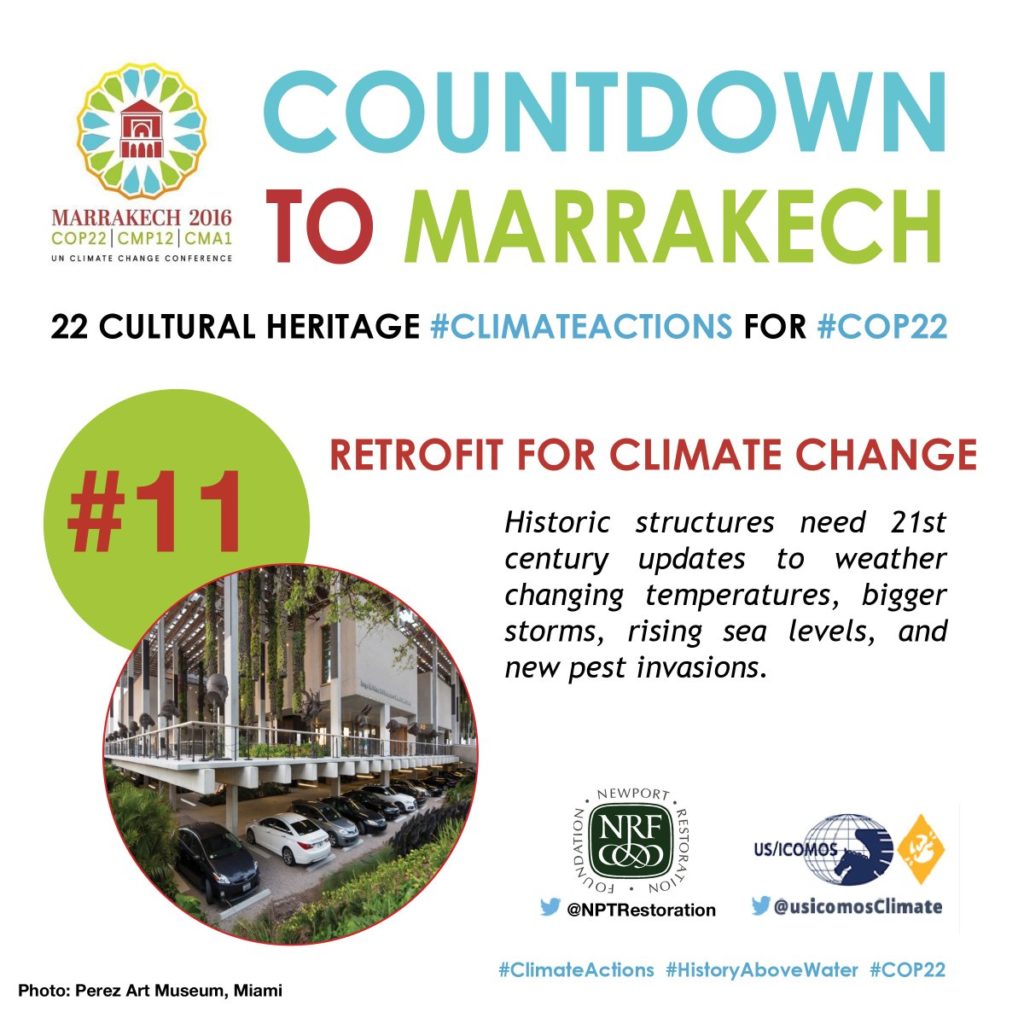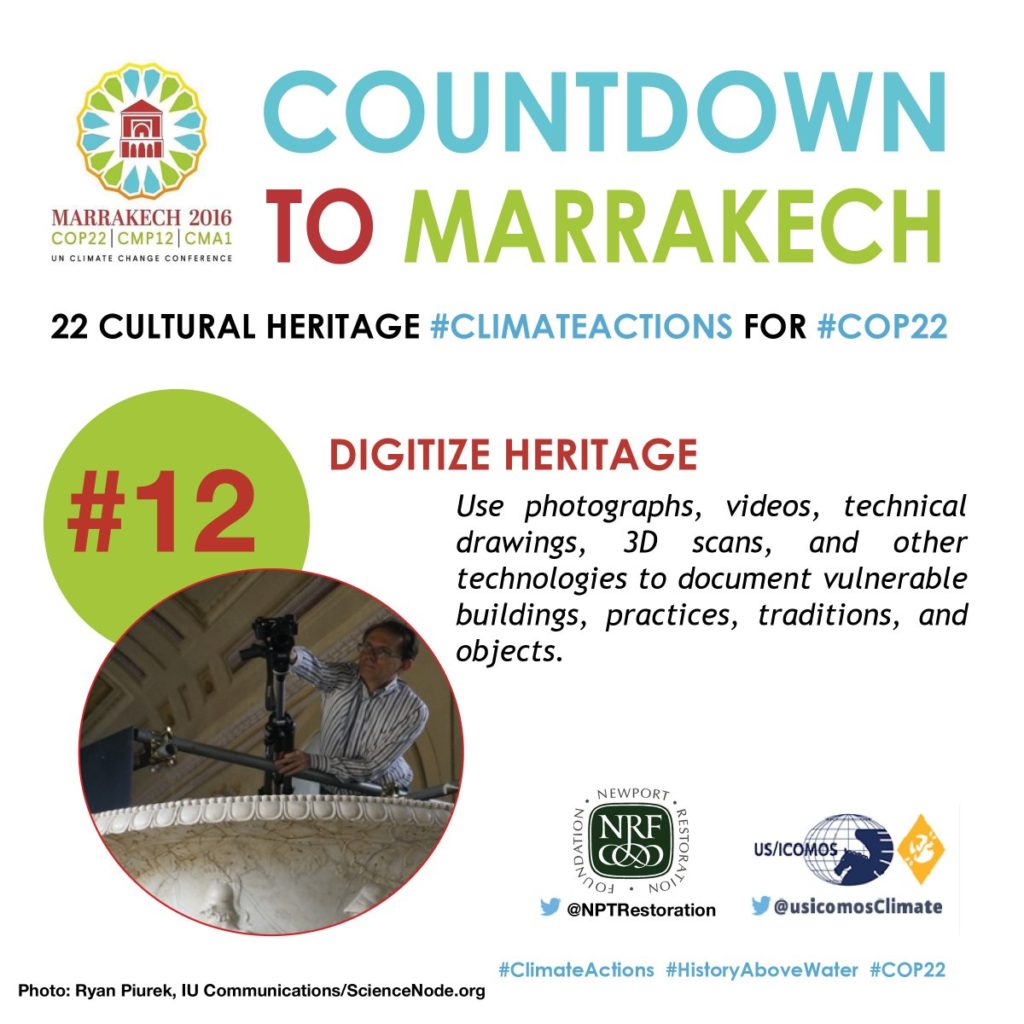In one week, thousands of government leaders, experts and stakeholders will assemble in Morocco for the next round of UN climate change talks known as COP22. Among them will be a small but dedicated band of US historic preservationists. The group is travelling to the Marrakech talks to join colleagues from around the world in addressing critical issues at the intersection of cultural heritage and climate change.
The COP22 official logo features Marrakech’s iconic Menara Gardens Pavilion. The pavilion, built during the 16th century Saadi dynasty and adjacent basin are part of a sophisticated, ancient irrigation system that uses underground channels called qanats.
(Above) The people of the Isle de Jean Charles Band of Biloxi-Chitimacha-Choctaw tribe are situated on the front line of Louisiana’s coastal land loss disaster and their ancestral home is sinking into the marsh.
A $48 million HUD grant is meant to allow the state to help them resettle their entire community to a safer place with a minimum of disruption to the community’s culture including livelihoods and lifestyles, creating a model for resettlement of endangered coastal communities throughout the United States.
Top on the cultural heritage agenda at COP22: pressing for a global effort to measure and value the impacts of climate change on heritage; promoting the role of heritage and traditional knowledge in climate change adaptation and mitigation; and accelerating the role of culture and heritage in climate displacement and mobility planning.While heritage has been represented at most of the recent COPs (thanks to indigenous organizations, UNESCO and a handful of heritage NGOs), “their number and prominence is growing” says US/ICOMOS’s Andrew Potts, outgoing ICOMOS Focal Point for the UN SDG Process. “Global processes like UN Sustainable Development Goals and the international climate change talks are finally reflecting the lessons of years of work on the intersection of heritage, sustainability and resilience,” Potts added.
Recognizing the import of COP22, the Newport Restoration Foundation and US/ICOMOS announced this week a new collaboration designed to significantly expand the US/ICOMOS Climate Change and Cultural Heritage Knowledge Community. The upcoming Marrakech talks “lent urgency to the launch of this new climate change and heritage collaboration” said Pieter N. Roos, NRF’s Executive Director. The Collaboration’s first project: a social media countdown of 22 heritage #ClimateActions leading up to COP22.
The Paris Agreement and the Road to COP22
The Conference of the Parties (COP) is the main decision-making body of the United National Framework Convention on Climate Change (UNFCCC). Its main task is to assess the actions taken by the 198 member countries to reduce their greenhouse gas emissions.
Last year’s COP21 in Paris, France was one of the largest gatherings of world leaders ever seen. It produced the Paris Agreement, arguably the most consequential climate change agreement in history. At its core is an agreement to keep global temperature increase below 2 degrees Celsius (and if possible, below 1.5C) through a significant reduction in greenhouse gas emissions. The Paris Agreement is set to go into effect on November 4, 2016, although it deals primarily with greenhouse gases emissions mitigation, adaptation and finance starting in the year 2020.
While heritage is not an express theme of the Paris Agreement, the accord does recognize the importance of both nature and culture in the climate change equation. For example, a key section speaks to “the importance of ensuring the integrity of all ecosystems, including oceans, and the protection of biodiversity, recognized by some cultures as Mother Earth.”
The Paris Agreement is a pillar of the UN’s Post-2015 Development Agenda, and is closely linked to other Agenda elements including the Sendai Framework for Disaster Risk Reduction, the Sustainable Development Goals and the New Urban Agenda. Implementing this agenda and monitoring its outcomes will be a global emphasis in the coming years including within ICOMOS, which has declared “sustainability” to be its 2018 international scientific theme.
The Paris Agreement and Cultural Heritage
President Barack Obama,and U.N. Secretary-General Ban Ki-moon shake hands in front of Chinese President Xi Jinping during a joint ratification of the Paris climate change agreement on September 3, 2016.
US/ICOMOS Responses to the Paris Agreement
The Paris Agreement framed a number of core issues that directly implicate cultural heritage and on which US historic preservationists have much to contribute. Key points of engagement for US/COMOS have included:
Why COP22 matters
This year’s COP — COP22 — will look to build on the Paris Agreement, discussing how to operationalize and implement the Agreement. At COP21 counties made emission-cutting pledges. The US, for example, pledged to cut U.S. climate pollution by 26-28% from 2005 levels. At COP22 countries are expected to submit their finalized climate change commitments, known as nationally determined contributions (“NDCs). Details on how to monitor and verify the commitments as well as climate financing will also continue to be discussed, alongside plans to scale up the ambition of the initial NDCs.
As the implementation of the Paris Agreement takes center stage, the role of heritage is also expected to come into better focus. These include displacement and mobility, loss and damage, and mitigation. “Many of heritage’s key priorities will be on the table in Marrakech,” said ICOMOS’s Potts.
With so much at stake and so much work yet to be done, it only makes sense for the cultural heritage community to make COP22 a priority. US/ICOMOS is supporting ICOMOS in co-hosting two official COP22 side events. US/ICOMOS’s goal is to “connect the Paris Agreement-related work of US historic preservationists to the international climate change conversation,” said Bill Pencek, US/ICOMOS’s new Executive Director.
The first of these events addresses how cultural heritage can be conserved for, and used as a resource by, communities displaced by climate change. Entitled “Culture on the Move: Sea Level Rise, Cultural Heritage and Climate Mobility,” it is being led by the International National Trust Organization (INTO) and the International Polar Foundation.
Cultural Heritage at COP22
The US contribution to the Mobility side event includes a presentation by National Geographic Explorer Victoria Herrmann on “America’s Eroding Edges” – a new collaboration with the National Trust for Historic Preservation that explores what America stands to lose as US communities experience the impacts of climate change on homes, livelihoods, and cultures.
The second event, “World Heritage and Water after Paris: Traditional Knowledge, Climate Impacts & Resilience,” looks at resilience, cultural heritage and how traditional water knowledge can inform contemporary disaster risk reduction & climate adaptation. The session is being led by two long-time US/ICOMOS partners, the Union of Concerned Scientists and the InterEnvironment Institute as well as the SeaTrust Institute. ICOMOS Morocco is also participating. The event precedes the “Water and Heritage for the Future” conference planned by ICOMOS Netherlands for November 25-26.
Connect Virtually to COP22
The US/ICOMOS-NRF collaboration is being launched in advance of COP22 to enhance US/ICOMOS’s existing web and social media-based Climate Change and Cultural Heritage Knowledge Community. The effort is designed to better connect the US historic preservation community to the world of climate change action. “The impacts of climate change like sea level rise know no boundaries, which puts a premium on international collaboration among heritage professionals,” said US/ICOMOS Trustee Lisa Craig. As chief of historic preservation for Annapolis, MD, Craig helped launch the “Weather it Together” initiative designed to help her historic coastal city prepare for disasters like those associated with rising seas. This new collaboration creates an international outlet for NRF’s successful Keeping History Above Water project (#HistoryAboveWater) which has focused on the nexus between sea level rise and coastal heritage.
The collaboration’s first project, a countdown of 22 cultural heritage #ClimateActions leading up to COP22 is available via www.usicomos.org and on twitter at @usicomosClimate.



Both the NRF collaboration and those that produced the COP22 side events are to some extent outgrowths of a meeting held in 2015 by a coalition of cultural heritage groups that produced the Pocantico Call to Action on Climate Impacts and Cultural Heritage. The Pocantico Call declares that cultural heritage is a human right being put at risk by climate change. Since the Pocantico meeting, US/ICOMOS has helped organizing heritage professionals into informal working groups to help represent cultural heritage voices and expertise in international climate policy discussions and processes. US/ICOMOS is grateful to its Pocantico partners and to the US National Park Service and the J.M. Kaplan Fund for their support in these efforts.
